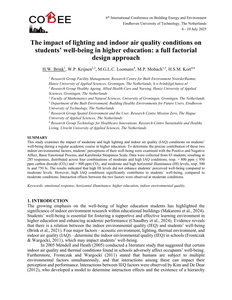Nightshift workers go against the natural sleep–wake rhythm. Light can shift the circadian clock but can also induce acute alertness. This placebo-controlled exploratory field study examined the effectiveness of light glasses to improve alertness while reducing the sleep complaints of hospital nurses working nightshifts. In a crossover within-subjects design, 23 nurses participated, using treatment glasses and placebo glasses. Sleepiness and sleep parameters were measured. A linear mixed model analysis on sleepiness revealed no significant main effect of the light intervention. An interaction e ect was found indicating that under the placebo condition, sleepiness was significantly higher on the first nightshift than on the last night, while under the treatment condition, sleepiness remainedstable across nightshift sessions. Sleepiness during the commute home also showed a significant interaction effect, demonstrating that after the first nightshift, driver sleepiness was higher for placebo than for treatment. Subjective sleep quality showed a negative main effect of treatment vs. placebo, particularly after the first nightshift. In retrospect, both types of light glasses were self-rated as effective. The use of light glasses during the nightshift may help to reduce driver sleepiness during the commute home, which is relevant, as all participants drove home by car or (motor) bike.
DOCUMENT
This study examines the impact of moderate and high lighting and indoor air quality (IAQ) conditions on students’ well-being during a regular academic course in higher education. To determine the precise contribution of these two indoor environmental factors, students’ perceptions of their well-being were examined with the Positive and Negative Affect, Basic Emotional Process, and Karolinska Sleepiness Scale. Data were collected from 83 students, resulting in 285 responses, distributed across four combinations of moderate and high IAQ conditions, resp. > 800 ppm ≤ 950 ppm carbon dioxide (CO2) and < 800 ppm CO2, and moderate and high horizontal illuminance (HI) levels, resp. 500 lx and 750 lx. The results indicated that high HI levels did not enhance students’ perceived well-being compared to moderate levels. However, high IAQ conditions significantly contributes to students’ well-being, compared to moderate conditions. Interaction effects between the two factors were observed at moderate conditions.
DOCUMENT

Light profoundly impacts many aspects of human physiology and behaviour, including the synchronization of the circadian clock, the production of melatonin, and cognition. These effects of light, termed the non-visual effects of light, have been primarily investigated in laboratory settings, where light intensity, spectrum and timing can be carefully controlled to draw associations with physiological outcomes of interest. Recently, the increasing availability of wearable light loggers has opened the possibility of studying personal light exposure in free-living conditions where people engage in activities of daily living, yielding findings associating aspects of light exposure and health outcomes, supporting the importance of adequate light exposure at appropriate times for human health. However, comprehensive protocols capturing environmental (e.g., geographical location, season, climate, photoperiod) and individual factors (e.g., culture, personal habits, behaviour, commute type, profession) contributing to the measured light exposure are currently lacking. Here, we present a protocol that combines smartphone-based experience sampling (experience sampling implementing Karolinska Sleepiness Scale, KSS ratings) and high-quality light exposure data collection at three body sites (near-corneal plane between the two eyes mounted on spectacle, neck-worn pendant/badge, and wrist-worn watch-like design) to capture daily factors related to individuals’ light exposure. We will implement the protocol in an international multi-centre study to investigate the environmental and socio-cultural factors influencing light exposure patterns in Germany, Ghana, Netherlands, Spain, Sweden, and Turkey (minimum n = 15, target n = 30 per site, minimum n = 90, target n = 180 across all sites). With the resulting dataset, lifestyle and context-specific factors that contribute to healthy light exposure will be identified. This information is essential in designing effective public health interventions.
MULTIFILE
